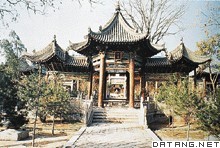1) Mosque at Huajuexiang


化觉巷清真寺
3) Zhenjue Temple


真觉寺
1.
Research on Shri Sariputra and the Construction of Zhenjue Temple;


印僧实哩沙哩卜得啰与真觉寺修建考
4) Mosque
[英][mɔsk] [美][mɑsk]


清真寺
1.
The Arabian Source of the Hui Mosque’s Building and Decorating Style in China;


简论中国回族清真寺建筑风格的阿拉伯源流
2.
Characteristic of Islamic art reflected by construction of Middle Ages mosque;


伊斯兰艺术特征在中世纪清真寺建筑中的反映
3.
Stating the Historical Architecture:Ibn Tulun Mosque;


诉说历史的建筑:伊本·土伦清真寺
5) mosques
[英][mɔsk] [美][mɑsk]


清真寺
1.
Islamic Architecture in Different Cultural Contexts——A Comparison of Mosques in Xinjiang and Other Provinces in China;
不同文化语境下的伊斯兰教建筑——新疆清真寺与内地清真寺之比较
2.
With a spatial perspective,the author takes women s spaces in contemporary Beijing s mosques as a research model,trying to uncover the spatial living conditions of muslin women, who are one part of the women-group,in contemporary Beijing city At the same time, women s space as a space category helps to enrich the domain of .
本文顺应这一潮流,从空间研究的角度出发,以北京清真寺中的女性空间为例,试图揭示作为女性群体之一的穆斯林女性在当代北京城市中的生存状况,并以“清真寺女性空间”这一空间类型丰富北京城市空间研究的范畴。
3.
Based on the Lanzhou Hui community in Qing Dynasty,the article discusses the ethnic identity function of mosques with history documents from anthropological view.
本文以清代兰州回族社区为背景,结合历史文献从人类学的角度对清真寺的族群认同功能进行论述。
补充资料:化觉巷清真寺
| 化觉巷清真寺 中国伊斯兰教清真寺。又称西安清真大寺,俗称东大寺。明万历三十四年(1606)冯从吾碑记中名清修寺。位于陕西省西安市化觉巷内。始建年代说法不一,一说为明洪武二十五年(1392)由赛哈智奉谕始建,万历三十四年、清乾隆三十年(1765)等年多次修葺扩建,遂成现今规模。
化觉巷清真寺规模宏大,东西向呈五进系列院落,南北建筑对称,设门楼、厅堂前后贯通。主体建筑为前后大殿、省心楼、凤凰亭、朝阳殿。中央凤凰亭为六角形,飞檐尖顶,形若凤头;两侧亭为三角形,左右翘翼,三亭相连呈凤凰展翅状。大殿可容千人礼拜,殿壁彩绘雕刻,天棚藻井有600余幅图画,西壁蔓草花卉套刻阿拉伯文字,均极为精致。寺内存有历代碑碣匾额及香炉、经匣、静物画等宗教文物。明末清初,该寺曾为陕西穆斯林经堂教育的中心。 |
说明:补充资料仅用于学习参考,请勿用于其它任何用途。
参考词条
